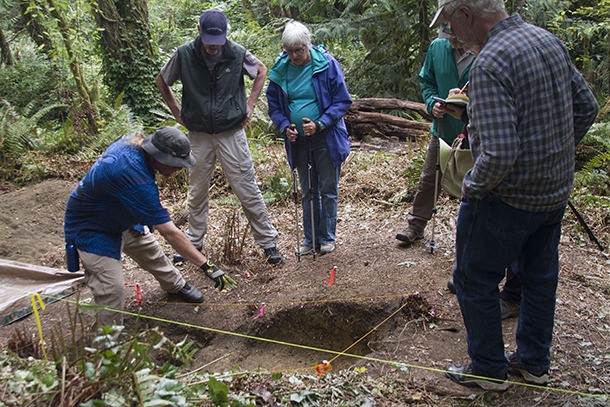While the rest of America was midway through the so-called Roaring Twenties, the collapse and migration that would come to define the fast-approaching Great Depression came early to the village of Yama on Bainbridge Island.
A small settlement of Japanese immigrants, almost all of whom worked at the nearby Blakely Mill, Yama was abandoned soon after the mill ceased operations in 1922. Once home to more than 50 small cottage-style houses and some 300 men, women and children, records indicate that by 1925 there was but a single person still living there.
The site was never heavily occupied before the Japanese came, and it has not been developed over since then, making it one of -—if not the — best preserved Japanese immigrant village sites in the Pacific Northwest, according to E. Floyd Aranyosi of Olympic College’s Department of Anthropology and the director of the summertime Yama Project field school.
The initial residents of Yama were among the first Japanese immigrants to the area, he said. The village was divided into two sections, one for young men and bachelor workers and the other for families with children. The Japanese brought with them many possessions and customs from their homeland, making the village relics a unique blend of Old and New World artifacts.
“The 1890s saw a lot of anti-Chinese sentiment,” Aranyosi said. “The Chinese Exclusion Act ultimately prohibited the mill from hiring Chinese people, and the Japanese were a suitable replacement.”
Researchers have worked for years to uncover Yama’s hidden past. The city of Bainbridge Island transferred ownership of the property to the Bainbridge Island Metropolitan Park & Recreation District, and the first serious scientific assessments of the site were done in the early ‘90s, Aranyosi said, when several archaeologists came, did a surface survey and recommended that the site be protected and receive further examination.
More recently, the Bainbridge Island Historical Museum, in partnership with the parks district, reached out to Olympic College for a more thorough survey and excavation of the Yama site.
“We’re running this not just as an excavation and surface survey analysis, but also as a field school to train students in archaeological field techniques,” Aranyosi explained.
The Yama Project and Archaeological Field School teaches students the principles of site survey, proper recording of provenience, artifact recovery, laboratory analysis, cataloging, curation and preparation of materials for museum exhibits, Aranyosi said, adding that it is an extremely unique opportunity for a community college program.
“Field schools generally do not run at the community college level,” he said. “Those are almost always run through universities and research institutions. So the student body of community colleges generally do not get these kind of experiences.”
About five anthropology, archeology and history students make up the crew, plus some from other disciplines and a few volunteers.
Rarer still, Aranyosi said, was the opportunity to have so perfect a site to sink a shovel. Despite nearly rampant development of the surrounding area in the wake of the mill closure, he said Yama “remained untouched.”
“Yama was the one neighborhood in the entire surrounding mill complex that did not get destroyed by subsequent development and that’s largely because it’s on such a steep slope,” he said. “It was not particularly appealing property for construction.”
The name itself, Yama, means hill.
“The preservation here is absolutely incredible,” he said. “We’re finding pieces of shoe leather on the surface. Rick [Chandler] found an oil crayon used in the lumber industry to write on lumber, to write sizes. Things like that usually do not last on the surface up here because the soil tends to be quite acidic.
“I was quite surprised at the quality of preservation at this site.”
Among the carefully measured and sectioned quadrants, Aranyosi’s students and volunteers scramble about the area documenting, measuring, sifting, digging and combing through the thick forest growth that has returned in the wake of the occupation of Yama.
It is the middle of the second of three eight-week field schools, the first being last summer.
The ultimate goal is a detailed map, carefully recovered and cataloged artifacts and a thorough report of the life of the people at Yama, which Aranyosi said should be finished next fall.
Relics will be stored at the Burke Museum of Natural History and Culture in Seattle, in accordance with state preservation requirements.
An in-depth study of the site would be a great asset to island historians, explained Bainbridge Island Historical Museum curator Rick Chandler.
“We would look at it as a resource that we would be able to interpret,” Chandler said.
“The parks department has held off on what their plans are for the place. They’re waiting, basically, for the research to be finished.”
Eventually, Chandler said, the museum would ideally collaborate with the parks department to develop the site in a way that both honors its historical significance and allows people to enjoy the natural area.
“They’d like to put a trail in, for instance, to the tea garden at Takayoshi [store], where all the pictures were taken with the gazebo,” he said.
“Rebuild the gazebo, have a photograph opportunity with some outdoor interpretive signage, maybe some kind of a walkway.”


